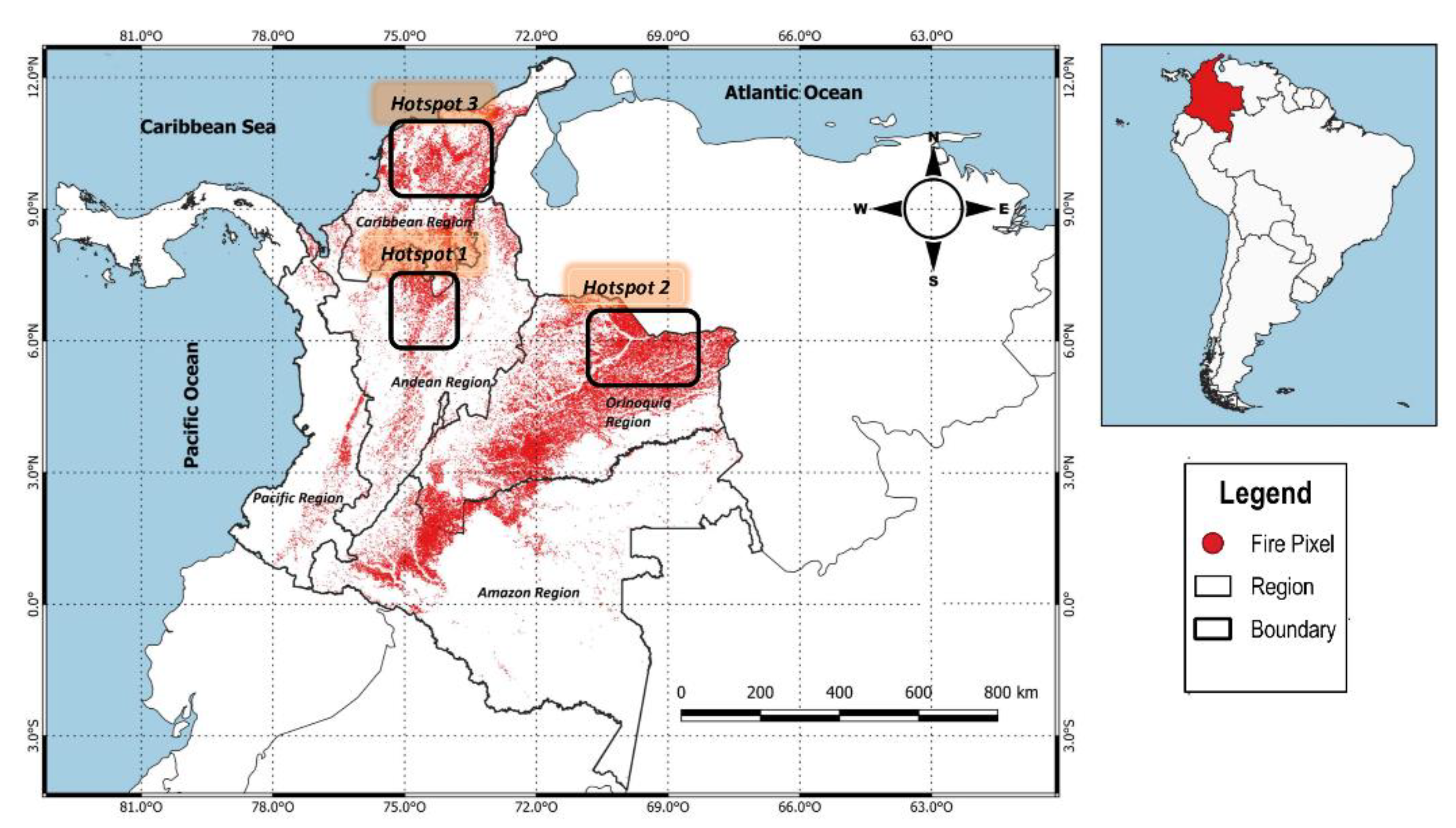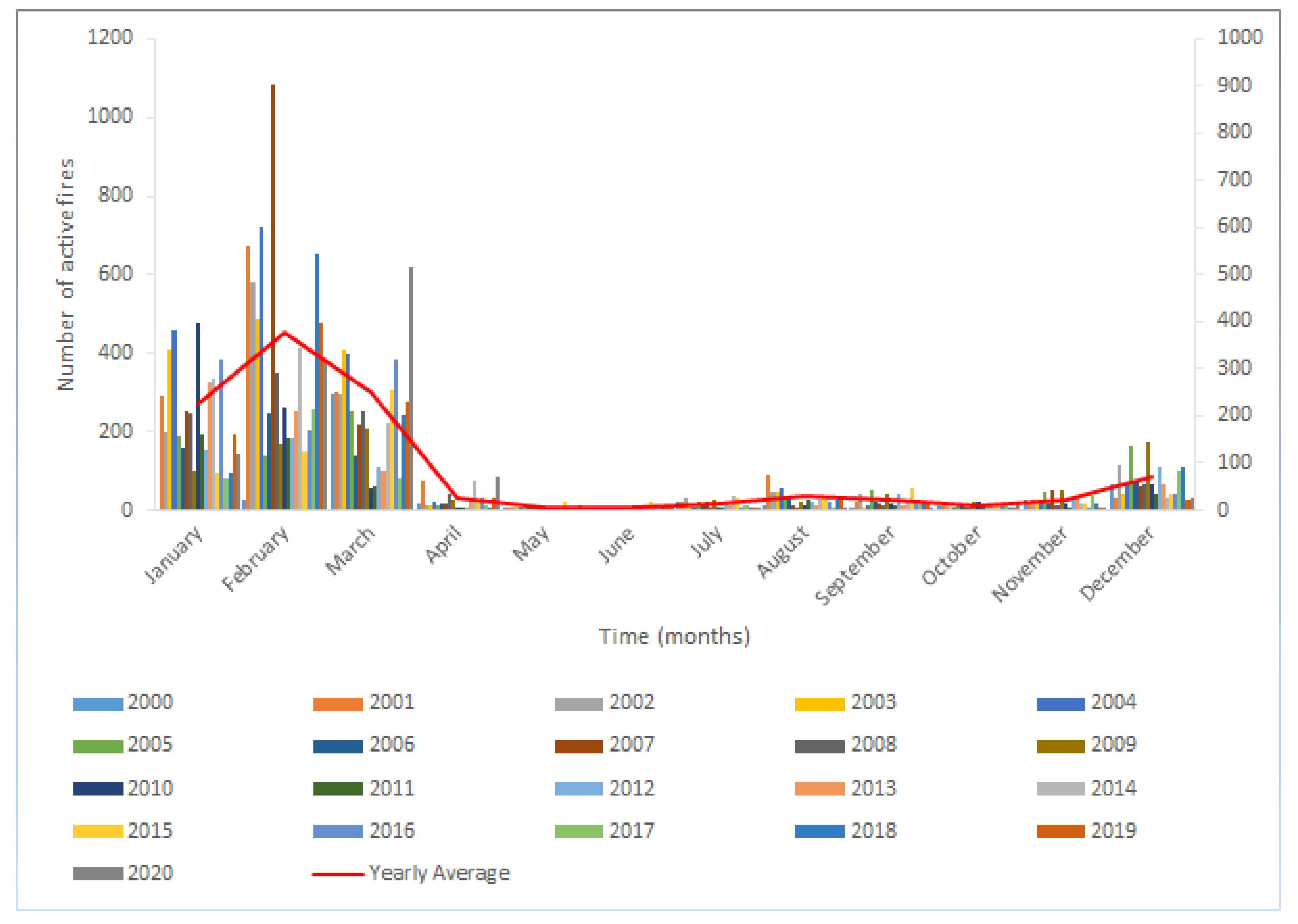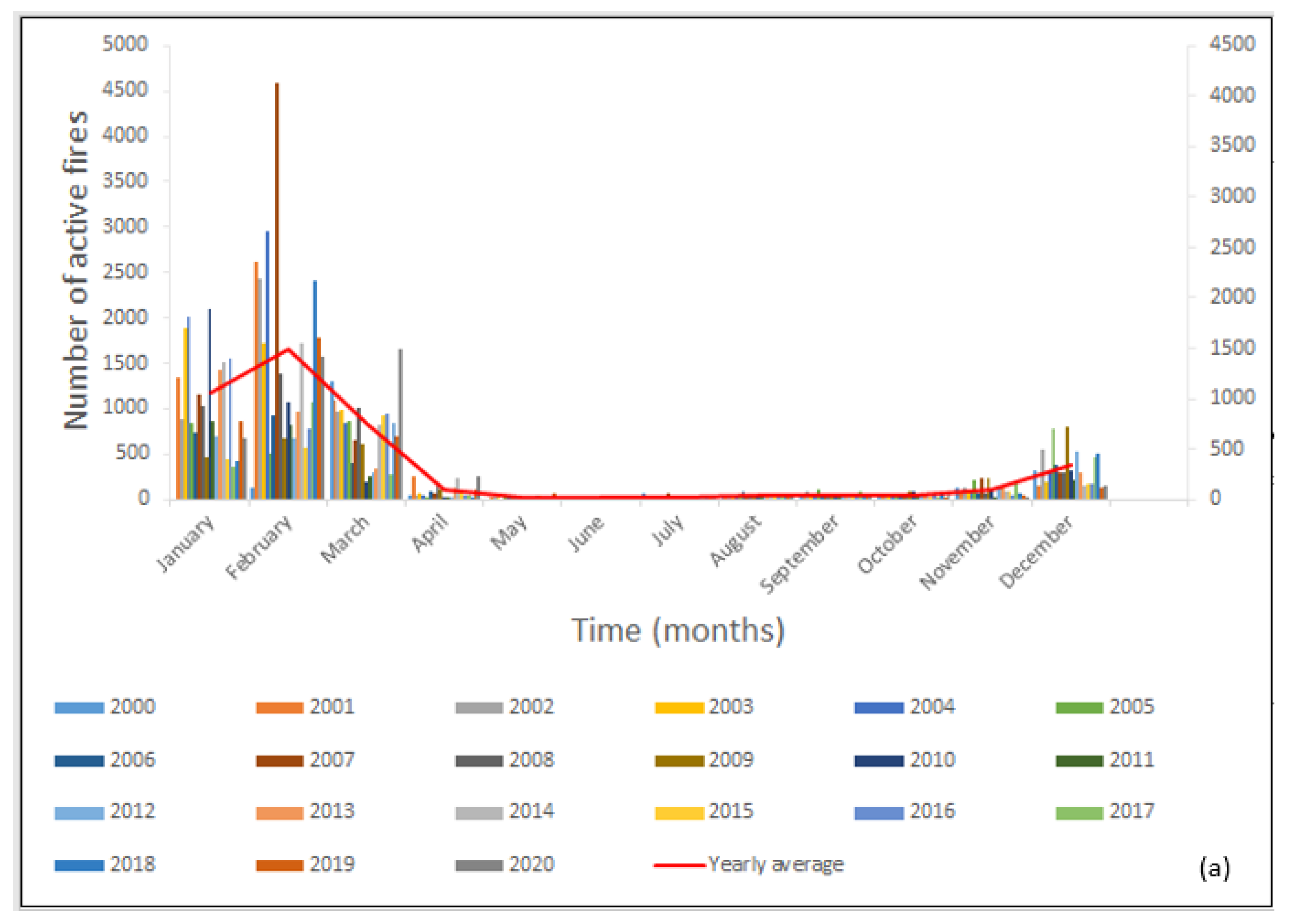Spatio-Temporal Characterization of Fire Using MODIS Data (2000–2020) in Colombia
Abstract
:1. Introduction
2. Materials and Methods
2.1. Study Area
2.2. Data and Sources
3. Results and Discussion
3.1. Colombia’s Regions and Their Relationship with Fire
3.2. Active Fires Spatial Distribution
3.3. Fire Density Variations
3.4. Fire Seasonality of the Regions over the Period 2000–2020
3.5. Relation between Fire Density and Temperature in the Main Fire Hotspots
4. Conclusions
Author Contributions
Funding
Data Availability Statement
Conflicts of Interest
References
- Masís, R.; Lizano, M. Análisis espacio-temporal de áreas quemadas en la región chorotega, costa rica entre 2001 y 2015. J. Chem. Inf. Model. 2019, 53, 1689–1699. [Google Scholar] [CrossRef]
- N’Dri, A.B.; Kone, A.W.; Loukou, S.K.K.; Barot, S.; Gignoux, J. Carbon and nutrient losses through biomass burning, and links with soil fertility and yam (dioscorea alata) production. Exp. Agric. 2019, 55, 738–751. [Google Scholar] [CrossRef]
- Vernooij, R.; Alves, M.V.G.; Borges, M.A.; Costa, M.M.; Barradas, A.C.S.; van der Werf, G. Seasonality of Greenhouse Gas Emission Factors from Biomass Burning in the Brazilian Cerrado. Biogeosci. Discuss. 2020, 1–32. [Google Scholar] [CrossRef]
- Adab, H.; Kanniah, K.D.; Solaimani, K. Modeling Forest Fire Risk in the Northeast of Iran Using Remote Sensing and GIS Techniques. Nat. Hazards 2013, 65, 1723–1743. [Google Scholar] [CrossRef]
- Stefanidis, S.; Alexandridis, V.; Spalevic, V.; Mincato, R.M. Wildfire Effects on Soil Erosion Dynamics: The Case of 2021 Megafires In Greece. Agric. For. 2022, 68, 15. [Google Scholar] [CrossRef]
- Efthimiou, N.; Psomiadis, E.; Panagos, P. Fire Severity and Soil Erosion Susceptibility Mapping Using Multi-Temporal Earth Observation Data: The Case of Mati Fatal Wildfire in Eastern Attica, Greece. CATENA 2020, 187, 104320. [Google Scholar] [CrossRef]
- Esposito, G.; Parodi, A.; Lagasio, M.; Masi, R.; Nanni, G.; Russo, F.; Alfano, S.; Giannatiempo, G. Characterizing Consecutive Flooding Events after the 2017 Mt. Salto Wildfires (Southern Italy): Hazard and Emergency Management Implications. Water 2019, 11, 2663. [Google Scholar] [CrossRef]
- Van der Werf, G.R.; Randerson, J.T.; Collatz, G.J.; Giglio, L. Carbon Emissions from Fires in Tropical and Subtropical Ecosystems. Glob. Change Biol. 2003, 9, 547–562. [Google Scholar] [CrossRef]
- Langenfelds, R.L.; Francey, R.J.; Pak, B.C.; Steele, L.P.; Lloyd, J.; Trudinger, C.M.; Allison, C.E. Interannual Growth Rate Variations of Atmospheric CO2 and Its Δ13C, H2, CH4, and CO between 1992 and 1999 Linked to Biomass Burning. Glob. Biogeochem. Cycles 2002, 16, 21-1–21-22. [Google Scholar] [CrossRef]
- Shi, G.; Yan, H.; Zhang, W.; Dodson, J.; Heijnis, H.; Burrows, M. Rapid Warming Has Resulted in More Wildfires in Northeastern Australia. Sci. Total Environ. 2021, 771, 144888. [Google Scholar] [CrossRef]
- Loiselle, D.; Du, X.; Alessi, D.S.; Bladon, K.D.; Faramarzi, M. Projecting Impacts of Wildfire and Climate Change on Streamflow, Sediment, and Organic Carbon Yields in a Forested Watershed. J. Hydrol. 2020, 590, 125403. [Google Scholar] [CrossRef]
- Abdollahi, M.; Islam, T.; Gupta, A.; Hassan, Q.K. An Advanced Forest Fire Danger Forecasting System: Integration of Remote Sensing and Historical Sources of Ignition Data. Remote Sens. 2018, 10, 923. [Google Scholar] [CrossRef]
- Rodríguez-Trejo, D.A.; Fulé, P.Z. Fire Ecology of Mexican Pines and a Fire Management Proposal. Int. J. Wildland Fire 2003, 12, 23–37. [Google Scholar] [CrossRef]
- Castillo, M.E.S.; Garfias, R.S.; Julio, G.A.; Gonzalez, L.R. Nativa De Chile. Red Rev. Científicas América Lat. el Caribe España y Port. 2012, 37, 796–804. [Google Scholar]
- San-Miguel-Ayanz, J.; Schulte, E.; Schmuck, G.; Camia, A.; Strobl, P.; Liberta, G.; Giovando, C.; Boca, R.; Sedano, F.; Kempeneers, P.; et al. Comprehensive Monitoring of Wildfires in Europe: The European Forest Fire Information System (EFFIS). In Approaches to Managing Disaster—Assessing Hazards, Emergencies and Disaster Impacts; IntechOpen: London, UK, 2012; pp. 87–109. ISBN 978-953-51-0294-6. [Google Scholar]
- Cizungu, N.C.; Tshibasu, E.; Lutete, E.; Mushagalusa, C.A.; Mugumaarhahama, Y.; Ganza, D.; Karume, K.; Michel, B.; Lumbuenamo, R.; Bogaert, J. Fire Risk Assessment, Spatiotemporal Clustering and Hotspot Analysis in the Luki Biosphere Reserve Region, Western DR Congo. Trees For. People 2021, 5, 100104. [Google Scholar] [CrossRef]
- Armenteras, D. Incendios En Ecosistemas Del Norte de Suramérica: Avances En La Ecología Del Fuego Tropical En Colombia, Ecuador y Perú Fire in the Ecosystems of Northern South America: Advances in the Ecology of Tropical. Caldasia 2020, 42, 1–16. [Google Scholar] [CrossRef]
- Munawar, H.S.; Ullah, F.; Khan, S.I.; Qadir, Z.; Qayyum, S. UAV Assisted Spatiotemporal Analysis and Management of Bushfires: A Case Study of the 2020 Victorian Bushfires. Fire 2021, 4, 40. [Google Scholar] [CrossRef]
- de Oliveira-Júnior, J.F.; Mendes, D.; Filho, W.L.F.C.; Junior, C.A.D.S.; de Gois, G.; Jardim, A.M.D.R.F.; da Silva, M.V.; Lyra, G.B.; Teodoro, P.E.; Pimentel, L.C.G.; et al. Fire Foci in South America: Impact and Causes, Fire Hazard and Future Scenarios. J. S. Am. Earth Sci. 2021, 112, 103623. [Google Scholar] [CrossRef]
- Hoyos, N.; Correa-Metrio, A.; Sisa, A.; Ramos-Fabiel, M.A.; Espinosa, J.M.; Restrepo, J.C.; Escobar, J. The Environmental Envelope of Fires in the Colombian Caribbean. Appl. Geogr. 2017, 84, 42–54. [Google Scholar] [CrossRef]
- Armenteras-Pascual, D.; Retana-Alumbreros, J.; Molowny-Horas, R.; Roman-Cuesta, R.M.; Gonzalez-Alonso, F.; Morales-Rivas, M. Characterising Fire Spatial Pattern Interactions with Climate and Vegetation in Colombia. Agric. For. Meteorol. 2011, 151, 279–289. [Google Scholar] [CrossRef]
- Armenteras, D.; Gonzalez-Alonso, F.; Franco Aguilera, C. Geographic and Temporal Distribution of Fire in Colombia Using Thermal Anomalies Data. Caldasia 2009, 31, 303–318. Available online: http://www.scielo.org.co/scielo.php?script=sci_arttext&pid=S0366-52322009000200007&lng=en&nrm=iso (accessed on 4 September 2021).
- Zúñiga-Vásquez, J.M.; Cisneros-González, D.; Pompa-García, M.; Rodríguez-Trejo, D.A.; Pérez-Verdín, G. Spatial Modeling of Forest Fires in Mexico: An Integration of Two Data Sources. Bosque 2017, 38, 563–574. [Google Scholar] [CrossRef]
- Csiszar, I.A.; Morisette, J.T.; Giglio, L. Validation of Active Fire Detection from Moderate-Resolution Satellite Sensors: The MODIS Example in Northern Eurasia. IEEE Trans. Geosci. Remote Sens. 2006, 44, 1757–1764. [Google Scholar] [CrossRef]
- Armenteras, D.; Gibbes, C.; Vivacqua, C.A.; Espinosa, J.S.; Duleba, W.; Goncalves, F.; Castro, C. Interactions between Climate, Land Use and Vegetation Fire Occurrences in El Salvador. Atmosphere 2016, 7, 26. [Google Scholar] [CrossRef]
- Hantson, S.; Padilla, M.; Corti, D.; Chuvieco, E. Strengths and Weaknesses of MODIS Hotspots to Characterize Global Fire Occurrence. Remote Sens. Environ. 2013, 131, 152–159. [Google Scholar] [CrossRef]
- Bajocco, S.; Koutsias, N.; Ricotta, C. Linking Fire Ignitions Hotspots and Fuel Phenology: The Importance of Being Seasonal. Ecol. Indic. 2017, 82, 433–440. [Google Scholar] [CrossRef]
- Gonzalez-Olabarria, J.R.; Brotons, L.; Gritten, D.; Tudela, A.; Teres, J.A. Identifying Location and Causality of Fire Ignition Hotspots in a Mediterranean Region. Int. J. Wildland Fire 2012, 21, 905–914. [Google Scholar] [CrossRef]
- Koutsias, N.; Allgöwer, B.; Kalabokidis, K.; Mallinis, G.; Balatsos, P.; Goldammer, J.G. Fire Occurrence Zoning from Local to Global Scale in the European Mediterranean Basin: Implications for Multi-Scale Fire Management and Policy. IForest 2016, 9, 195–204. [Google Scholar] [CrossRef]
- Hayasaka, H.; Yamazaki, K.; Naito, D. Weather Conditions and Warm Air Masses during Active Fire-Periods in Boreal Forests. Polar Sci. 2019, 22, 100472. [Google Scholar] [CrossRef]
- Carmel, Y.; Paz, S.; Jahashan, F.; Shoshany, M. Assessing Fire Risk Using Monte Carlo Simulations of Fire Spread. For. Ecol. Manag. 2009, 257, 370–377. [Google Scholar] [CrossRef]
- PNUD PNUD Colombia. Available online: https://www.co.undp.org/content/colombia/es/home/countryinfo.html (accessed on 3 December 2021).
- Urrea, V.; Ochoa, A.; Mesa, O. Seasonality of Rainfall in Colombia. Water Resour. Res. 2019, 55, 4149–4162. [Google Scholar] [CrossRef]
- Chuvieco, E.; Ventura, G.; Martín, M.P.; Gómez, I. Assessment of Multitemporal Compositing Techniques of MODIS and AVHRR Images for Burned Land Mapping. Remote Sens. Environ. 2005, 94, 450–462. [Google Scholar] [CrossRef]
- Giglio, L.; Schroeder, W.; Justice, C.O. The Collection 6 MODIS Active Fire Detection Algorithm and Fire Products. Remote Sens. Environ. 2016, 178, 31–41. [Google Scholar] [CrossRef] [PubMed]
- Fusco, E.J.; Finn, J.T.; Abatzoglou, J.T.; Balch, J.K.; Dadashi, S.; Bradley, B.A. Detection Rates and Biases of Fire Observations from MODIS and Agency Reports in the Conterminous United States. Remote Sens. Environ. 2019, 220, 30–40. [Google Scholar] [CrossRef]
- Hawbaker, T.J.; Radeloff, V.C.; Syphard, A.D.; Zhu, Z.; Stewart, S.I. Detection Rates of the MODIS Active Fire Product in the United States. Remote Sens. Environ. 2008, 112, 2656–2664. [Google Scholar] [CrossRef]
- Peterson, D.; Wang, J.; Ichoku, C.; Hyer, E.; Ambrosia, V. A Sub-Pixel-Based Calculation of Fire Radiative Power from MODIS Observations: 1: Algorithm Development and Initial Assessment. Remote Sens. Environ. 2013, 129, 262–279. [Google Scholar] [CrossRef]
- Wang, W.; Qu, J.J.; Hao, X.; Liu, Y. Analysis of the Moderate Resolution Imaging Spectroradiometer Contextual Algorithm for Small Fire Detection. Appl. Remote Sens. 2009, 3, 031502. [Google Scholar] [CrossRef]
- Wang, W.; Qu, J.J.; Hao, X.; Liu, Y.; Sommers, W.T. An Improved Algorithm for Small and Cool Fire Detection Using MODIS Data: A Preliminary Study in the Southeastern United States. Remote Sens. Environ. 2007, 108, 163–170. [Google Scholar] [CrossRef]
- Schroeder, W.; Prins, E.; Giglio, L.; Csiszar, I.; Schmidt, C.; Morisette, J.; Morton, D. Validation of GOES and MODIS Active Fire Detection Products Using ASTER and ETM+ Data. Remote Sens. Environ. 2008, 112, 2711–2726. [Google Scholar] [CrossRef]
- Hardesty, J.; Myers, R.; Fulks, F. Fire, Ecosystems and People: A Preliminary Assessment of Fire as a Global Conservation Issue; George Wright Society: Hancock, MI, USA, 2005. [Google Scholar]
- Armenteras, D.; Cabrera, E.; Rodrı, N. National and Regional Determinants of Tropical Deforestation in Colombia. Reg. Environ. Chang. 2013, 13, 1181–1193. [Google Scholar] [CrossRef]
- Fontanilla-Díaz, C.A.; Preckel, P.V.; Lowenberg-DeBoer, J.; Sanders, J.; Peña-Lévano, L.M. Identifying Profitable Activities on the Frontier: The Altillanura of Colombia. Agric. Syst. 2021, 192, 103199. [Google Scholar] [CrossRef]
- Chivatá López, V. Análisis Espacial Comparativo de Los Focos de Calor Con Las Coberturas de La Tierra Corine Land Cover y El Ráster de Susceptibilidad a Incendios de La Cobertura Vegetal; Universidad Militar Nueva Granada: Bogotá, Colombia, 2017. [Google Scholar]
- Chivata Lopéz, V. Comparative Spatial Analysis of the Heat Points with the Land Coverings and the Raster of Susceptibility to the Forest; 2017. Available online: https://repository.unimilitar.edu.co/handle/10654/16446 (accessed on 3 December 2021).
- Sánchez Ojeda, F.; Armenteras Pascual, D.; Sánchez Ojeda, F.; Armenteras Pascual, D. Changes in Soil Organic Carbon after Burning in a Forest-Savanna Edge. Acta Agronómica 2017, 66, 519–524. [Google Scholar] [CrossRef]
- Soro, T.D.; Koné, M.; N’Dri, A.B.; N’Datchoh, E.T. Identified Main Fire Hotspots and Seasons in Côte d’Ivoire (West Africa) Using MODIS Fire Data. S. Afr. J. Sci. 2021, 117, 1–13. [Google Scholar] [CrossRef]
- IDEAM. Boletín Informativo Sobre El Monitoreo de Los Fenómenos de Variabilidad Climática “El Niño” y “La Niña”; IDEAM: Bogota, Colombia, 2017.
- Poveda, G.; Waylen, P.R.; Pulwarty, R.S. Annual and Inter-Annual Variability of the Present Climate in Northern South America and Southern Mesoamerica. Palaeogeogr. Palaeoclimatol. Palaeoecol. 2006, 234, 3–27. [Google Scholar] [CrossRef]
- Huesca, M.; Gonzáles, A.; Cuevas, M. Distribución Espacial Y Temporal De Los Incendios Forestales En España Utilizando Datos De Anomalías Térmicas; 2009; pp. 309–3012. Available online: https://ris.utwente.nl/ws/files/267089960/DISTRIBUCION_ESPACIAL_Y_TEMPORAL_DE_LOS_INCENDIOS_.pdf (accessed on 3 December 2021).
- Strydom, S.; Savage, M.J. A Spatio-Temporal Analysis of Fires in South Africa. S. Afr. J. Sci. 2016, 112, 1–8. [Google Scholar] [CrossRef] [Green Version]








| Regions | ||||
|---|---|---|---|---|
| Amazon | Andean | Caribbean | Orinoquia | Pacific |
| Cs | Cs | Cs | Cs | Cs |
| 0.1117 | 0.7506 * | 0.5571 * | 0.3429 | 0.7364 * |
Publisher’s Note: MDPI stays neutral with regard to jurisdictional claims in published maps and institutional affiliations. |
© 2022 by the authors. Licensee MDPI, Basel, Switzerland. This article is an open access article distributed under the terms and conditions of the Creative Commons Attribution (CC BY) license (https://creativecommons.org/licenses/by/4.0/).
Share and Cite
Bolaño-Díaz, S.; Camargo-Caicedo, Y.; Soro, T.D.; N’Dri, A.B.; Bolaño-Ortiz, T.R. Spatio-Temporal Characterization of Fire Using MODIS Data (2000–2020) in Colombia. Fire 2022, 5, 134. https://doi.org/10.3390/fire5050134
Bolaño-Díaz S, Camargo-Caicedo Y, Soro TD, N’Dri AB, Bolaño-Ortiz TR. Spatio-Temporal Characterization of Fire Using MODIS Data (2000–2020) in Colombia. Fire. 2022; 5(5):134. https://doi.org/10.3390/fire5050134
Chicago/Turabian StyleBolaño-Díaz, Sindy, Yiniva Camargo-Caicedo, Tionhonkélé D. Soro, Aya Brigitte N’Dri, and Tomás R. Bolaño-Ortiz. 2022. "Spatio-Temporal Characterization of Fire Using MODIS Data (2000–2020) in Colombia" Fire 5, no. 5: 134. https://doi.org/10.3390/fire5050134
APA StyleBolaño-Díaz, S., Camargo-Caicedo, Y., Soro, T. D., N’Dri, A. B., & Bolaño-Ortiz, T. R. (2022). Spatio-Temporal Characterization of Fire Using MODIS Data (2000–2020) in Colombia. Fire, 5(5), 134. https://doi.org/10.3390/fire5050134











